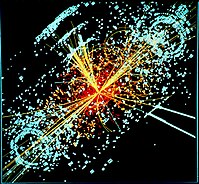
Photo from wikipedia
The dynamical mass of galaxies and the Newtonian acceleration generated from the baryons have been found to be strongly correlated. This correlation is known as 'Mass-Discrepancy Acceleration Relation' (MDAR). Further… Click to show full abstract
The dynamical mass of galaxies and the Newtonian acceleration generated from the baryons have been found to be strongly correlated. This correlation is known as 'Mass-Discrepancy Acceleration Relation' (MDAR). Further investigations have revealed a tighter relation - 'Radial Acceleration Relation' (RAR) - between the observed total acceleration and the (Newtonian) acceleration produced by the baryons. So far modified gravity theories have remained more successful than $\Lambda$CDM to explain these relations. However, a recent investigation has pointed out that, when RAR is expressed as a difference between the observed acceleration and the expected Newtonian acceleration due to baryons (which has been called the 'Halo acceleration relation or HAR'), it provides a stronger test for modified gravity theories and dark matter hypothesis. Extending our previous work \citep{kt2018}, we present a case study of modified gravity theories, in particular Weyl conformal gravity and Modified Newtonian Dynamics (MOND), using recent inferred acceleration data for the Milky Way. We investigate how well these theories of gravity and the RAR scaling law can explain the current observation.
Journal Title: Physical Review D
Year Published: 2020
Link to full text (if available)
Share on Social Media: Sign Up to like & get
recommendations!